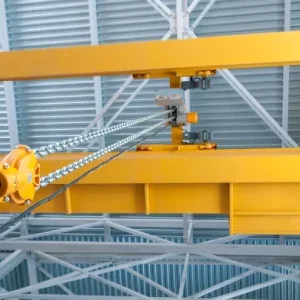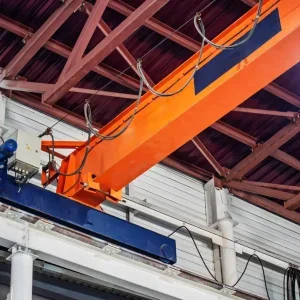The 35.76 ft. (10.9m)-long by 7.2 ft. (2.2m)-wide by 7.7 ft. (2.35m)-high steel frame, provided by Caldwell’s Illinois-based distributor John Sakash Company, weighs 12,787 lbs. unloaded and 40,345 lbs. loaded. Cryomodules will sit on seven aluminum cradles, also manufactured by Caldwell, within the frame for road transportation and aboard a Boeing 747-400F, an all-cargo airplane.
Fermi National Accelerator Laboratory’s (Fermilab) Proton Improvement Plan II (PIP-II) Project plans the assembly of three high-beta 650MHz (HB650) cryomodules at STFC-UKRI in the UK.
The completed modules must be safely transported to FNAL in Illinois, USA. To achieve this a transport frame was designed to protect the cryomodules during transit. The entire project was a collaborative effort involving extensive meetings between Caldwell, John Sakash, and Fermilab.
Using a crane, a cryomodule will be lowered through the top opening of the frame onto supports underneath the cryomodule. This will allow safe alignment and attachment of the cradles. The top guard is then lowered into position, and instrumentation can be mounted onto the central platforms.
The frame, originally designed by STFC-UKRI, a partner institution with Fermilab on PIP-II, meets requirements for shock, vibration, lifting, and transport loads in both the United States and Europe. The frame features four lifting points to stabilize the load, connected to a top sling at an angle of 30 degrees to accommodate headroom requirements; the sling spread will be 23.2 ft. (7.07m) by 7 ft. (2.13m).
Dan Mongan, senior sales engineer, Caldwell, explained the selected RUD lifting eyes are high capacity fittings selected to accommodate the low headroom, 30-degree sling angle.
“This isn’t a level of engineering and manufacturing capability that is readily available within the industry. The frame will likely be used on three occasions, but they must have complete trust in the whole system, given the value and importance of the load and the transatlantic journey it will take. Thusly, shock absorption was a major part of the design. The last thing that anyone wants is for the cryomodule to get shaken around during shipping. The type of shock absorbers that they’re using were specified by PIP-II engineers,” said Pete Sakash, GM, John Sakash Company.
Cream City Scale, also of Illinois, was contracted by Caldwell to complete a 200% load test, during which each cradle needed to be loaded. The job was approved on 21 May 2021 and shipped on 30 November 2021.
“What stands out to me is the whole collaborative aspect of it. So many people are involved in this—contractors, manufacturers, engineers, various countries, etc.—and it’s all just for research. They’re not building a bridge, or expanding a highway, or putting up a building, they’re doing experiments to try and find out more about our universe. It’s an honor to be a part of it,” added Sakash.
He said John Sakash Company and Caldwell are already collaborating on provision of a dummy load to fit inside the frame for a spring 2022 test run. Sensors will be used to record the movements and stresses put on the dummy load inside the transport frame.






